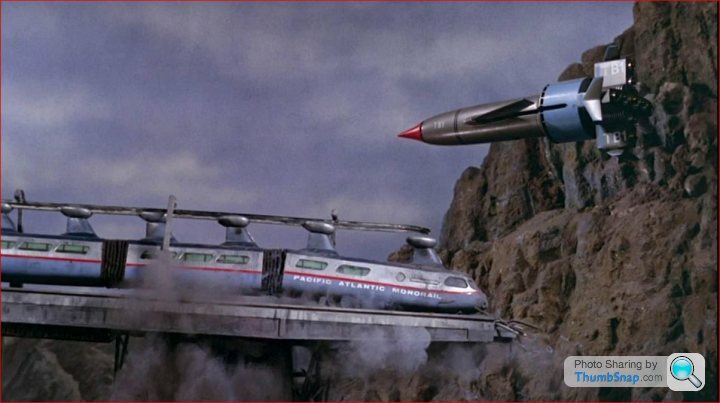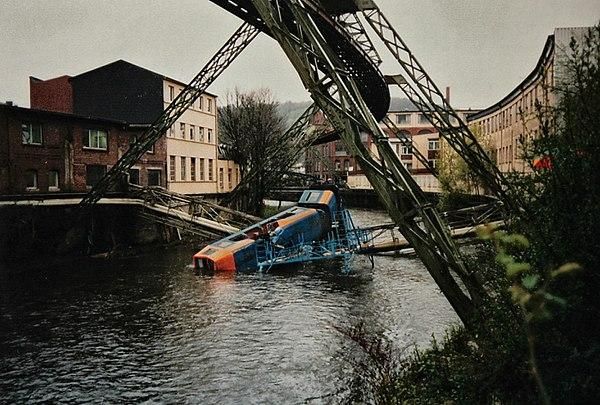Why aren't there more monorails in the UK?
Discussion
There is no national/international standard for monorail so virtually all the infrastructure and rolling stock has to be bespoke. Even if you copy an existing system design it won't have economy of scale in comparison to mass-produced steel rail and concrete or steel sleepers, ballast etc.
Monorail systems aren't compatible with 'traditional' rail, so are immediately restricted to branch/shuttle services. You also need bespoke maintenance and servicing facilities.
There is no simple and cost-effective way of making points/switches for monorail and system designers put a lot of effort into minimising them. This makes monorails best suited to simple shuttle or loop systems, not a diverse multi-path network like traditional rail. That immediately puts limits on service patterns and frequency.
Monorails do not save much in construction costs over conventional rail. The track is much more expensive per mile. The track may be elevated but you still need to acquire the land or the rights to run it across. If you build them above public roads you commit to following the curves, humps and bumps of the road, limiting the maximum speed and turning your monorail into a more expensive and less flexible bus.
Reinstating abandoned heavy rail (with modern light or basic rail) is still the most cost-effective solution if rail has to be the answer. Monorail do have use cases as mass transit in urban areas but not as rural branch lines.
Monorail systems aren't compatible with 'traditional' rail, so are immediately restricted to branch/shuttle services. You also need bespoke maintenance and servicing facilities.
There is no simple and cost-effective way of making points/switches for monorail and system designers put a lot of effort into minimising them. This makes monorails best suited to simple shuttle or loop systems, not a diverse multi-path network like traditional rail. That immediately puts limits on service patterns and frequency.
Monorails do not save much in construction costs over conventional rail. The track is much more expensive per mile. The track may be elevated but you still need to acquire the land or the rights to run it across. If you build them above public roads you commit to following the curves, humps and bumps of the road, limiting the maximum speed and turning your monorail into a more expensive and less flexible bus.
Reinstating abandoned heavy rail (with modern light or basic rail) is still the most cost-effective solution if rail has to be the answer. Monorail do have use cases as mass transit in urban areas but not as rural branch lines.
IJWS15 said:
How do you evacuate passengers from an elevated monorail when it fails?
Ask Derek & CliveNSFW
There is one up the lane from here. Might not win many awards for passenger comfort, and it not quite in Wales, but it used to be in Wales.
https://www.tanatvalleyrailway.co.uk/monorail
https://www.tanatvalleyrailway.co.uk/monorail
The main issue is NIMBYism.
Just consider how much of HS2 has been buried to protect NIMBYs from their view. A monorail (or even a raised railway on concrete pillars, like in much of China's network), is actually a fairly modular and simple way to build light rail (I.e. foundation and pillar heights are adjusted for topography, track bed is modular and standardised). But it puts the tracks at height, and no one will agree to that.
Consider some cities with their raised railway systems. You see very little of that in the UK.
Just consider how much of HS2 has been buried to protect NIMBYs from their view. A monorail (or even a raised railway on concrete pillars, like in much of China's network), is actually a fairly modular and simple way to build light rail (I.e. foundation and pillar heights are adjusted for topography, track bed is modular and standardised). But it puts the tracks at height, and no one will agree to that.
Consider some cities with their raised railway systems. You see very little of that in the UK.
FourWheelDrift said:
Instead of a monorail What about an elevated railway instead?
This one was built in 1897 and is still in use today.
And yet Maglev never (to any great extent) happened.This one was built in 1897 and is still in use today.
https://en.m.wikipedia.org/wiki/Transrapid
Gassing Station | Boats, Planes & Trains | Top of Page | What's New | My Stuff







